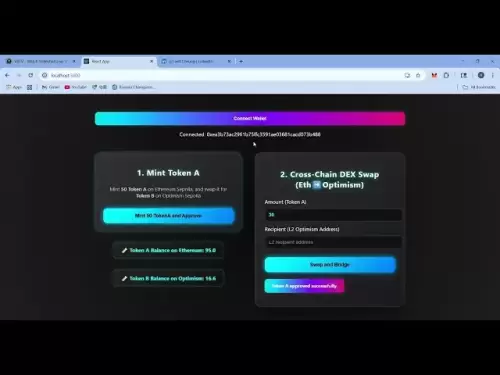-
 Bitcoin
Bitcoin $109,459.7682
2.44% -
 Ethereum
Ethereum $2,598.6052
6.29% -
 Tether USDt
Tether USDt $1.0003
0.00% -
 XRP
XRP $2.2734
3.95% -
 BNB
BNB $661.4886
1.58% -
 Solana
Solana $155.4825
4.35% -
 USDC
USDC $0.9999
-0.02% -
 TRON
TRON $0.2838
1.04% -
 Dogecoin
Dogecoin $0.1740
8.25% -
 Cardano
Cardano $0.6047
9.04% -
 Hyperliquid
Hyperliquid $40.2302
6.50% -
 Sui
Sui $2.9863
10.05% -
 Bitcoin Cash
Bitcoin Cash $509.5786
0.60% -
 Chainlink
Chainlink $13.8156
6.03% -
 UNUS SED LEO
UNUS SED LEO $9.0142
0.69% -
 Avalanche
Avalanche $19.0337
8.68% -
 Stellar
Stellar $0.2438
5.17% -
 Toncoin
Toncoin $2.9012
3.59% -
 Shiba Inu
Shiba Inu $0.0...01210
6.20% -
 Litecoin
Litecoin $90.0882
7.05% -
 Hedera
Hedera $0.1597
8.53% -
 Monero
Monero $326.3340
2.88% -
 Polkadot
Polkadot $3.6365
9.32% -
 Bitget Token
Bitget Token $4.6162
2.72% -
 Dai
Dai $1.0001
0.00% -
 Ethena USDe
Ethena USDe $1.0002
-0.01% -
 Uniswap
Uniswap $7.6403
10.47% -
 Pepe
Pepe $0.0...01060
12.03% -
 Aave
Aave $281.3664
7.56% -
 Pi
Pi $0.4992
1.76%
What is the leverage ratio of bitcoin futures contracts?
Leverage in Bitcoin futures contracts magnifies returns, increases margin call susceptibility, and demands effective risk management strategies for successful trading outcomes.
Nov 19, 2024 at 01:42 pm

Understanding Leverage in Bitcoin Futures Contracts
Leverage is a financial tool that allows traders to increase their potential profits by borrowing funds from a broker. In the context of Bitcoin futures contracts, leverage allows traders to take on positions that are larger than their initial investment. This can amplify both profits and losses, making it a high-risk, high-reward trading strategy.
Calculating the Leverage Ratio
The leverage ratio in Bitcoin futures contracts is calculated by dividing the notional value of the contract by the margin requirement. The notional value represents the total value of the underlying Bitcoin, while the margin requirement is the amount of capital that the trader must maintain in their account to open and maintain the position.
For example, if a trader enters into a Bitcoin futures contract with a notional value of $100,000 and a margin requirement of $10,000, the leverage ratio would be 10:1. This means that the trader has borrowed $90,000 from the broker to increase their exposure to Bitcoin.
Impact of Leverage on Trading
Leverage can significantly impact the outcomes of Bitcoin futures trading. Here's how it works:
- Magnified Returns: Leverage amplifies both profits and losses. If the price of Bitcoin moves in the trader's favor, the trader can make a substantial profit due to the increased exposure provided by leverage. However, if the price moves against the trader, the losses can be amplified as well.
- Increased Margin Calls: When the price of Bitcoin moves against the trader's position, the broker may issue a margin call demanding that the trader add more capital to their account. If the trader cannot meet the margin call, the broker may liquidate the position, leading to substantial losses.
- Risk Management: Leverage increases the volatility of Bitcoin futures trading, making risk management crucial. Traders must implement stop-loss orders, limit orders, and position sizing strategies to mitigate potential losses.
Leverage in Practice
Traders can access different leverage levels offered by various cryptocurrency exchanges. Typically, leverage ratios range from 1:2 to 100:1, with popular exchanges like Binance and Bybit offering leverage as high as 50:1 or more.
The optimal leverage ratio for a trader depends on their risk tolerance, account size, and trading strategy. Risk-averse traders may prefer lower leverage ratios, while more aggressive traders may opt for higher leverage to maximize potential returns.
Conclusion
Leverage is a powerful tool that can enhance the potential profits of Bitcoin futures trading, but it also carries substantial risks. Traders must carefully consider their risk tolerance, account size, and trading strategy when determining the appropriate leverage ratio to use.
Disclaimer:info@kdj.com
The information provided is not trading advice. kdj.com does not assume any responsibility for any investments made based on the information provided in this article. Cryptocurrencies are highly volatile and it is highly recommended that you invest with caution after thorough research!
If you believe that the content used on this website infringes your copyright, please contact us immediately (info@kdj.com) and we will delete it promptly.
- Crypto Summer Buys: Is Shiba Inu Out, and What's In?
- 2025-07-03 18:30:12
- Bitcoin, Solaris Presale, and Coin Watch: Catching the Next Wave
- 2025-07-03 19:10:11
- BONK ETF Buzz: Catalyst for a Meme Coin Moonshot?
- 2025-07-03 19:50:12
- Sui Coin, Bitcoin Solaris, and the Presale Opportunity: Catching the Next Wave
- 2025-07-03 19:50:12
- Sui Coin, Bitcoin Solaris, and Presale Opportunities: What's the Buzz?
- 2025-07-03 19:55:14
- MEXC's Bitcoin Reserves: A Fortress of Asset Coverage
- 2025-07-03 19:55:14
Related knowledge

How to identify the contract value range in combination with the market profile?
Jul 02,2025 at 10:56pm
Understanding the Market ProfileTo effectively identify the contract value range in combination with the market profile, it's essential to first understand what each concept entails. The market profile is a framework that helps traders visualize how price and time interact across a given period, typically a trading day or session. It provides insights i...

How to use the price slope to filter the false breakthrough signal of the contract?
Jun 20,2025 at 06:56pm
Understanding the Concept of Price Slope in Contract TradingIn contract trading, especially within cryptocurrency derivatives markets, price slope refers to the rate at which the price changes over a specific time period. It helps traders assess the strength and sustainability of a trend. A steep slope may indicate strong momentum, while a shallow slope...

How to determine the expected volatility of the contract through the volatility cone?
Jun 19,2025 at 12:28pm
Understanding the Basics of Volatility in Cryptocurrency ContractsIn the realm of cryptocurrency trading, volatility is a key metric that traders use to assess potential risk and reward. When dealing with futures contracts, understanding how volatile an asset might become over time is crucial for position sizing, risk management, and strategy developmen...

How to formulate a contract intraday trading plan in combination with the pivot point system?
Jun 21,2025 at 03:42pm
Understanding the Basics of Pivot Points in Cryptocurrency TradingPivot points are technical analysis tools used by traders to identify potential support and resistance levels. These levels are calculated using the previous day's high, low, and closing prices. In the context of cryptocurrency trading, where markets operate 24/7, pivot points help trader...

How to adjust the contract position ratio through the price fluctuation entropy?
Jun 22,2025 at 11:42am
Understanding Price Fluctuation Entropy in Cryptocurrency ContractsIn the world of cryptocurrency futures trading, price fluctuation entropy is a relatively new concept used to measure market volatility and uncertainty. It derives from information theory, where entropy refers to the degree of randomness or unpredictability in a system. In crypto contrac...

How to use the volume swing indicator to predict the contract volume-price divergence?
Jun 18,2025 at 11:42pm
Understanding the Volume Swing IndicatorThe volume swing indicator is a technical analysis tool used primarily in cryptocurrency trading to evaluate changes in volume over time. Unlike price-based indicators, this metric focuses solely on trading volume, which can provide early signals about potential market reversals or continuations. The key idea behi...

How to identify the contract value range in combination with the market profile?
Jul 02,2025 at 10:56pm
Understanding the Market ProfileTo effectively identify the contract value range in combination with the market profile, it's essential to first understand what each concept entails. The market profile is a framework that helps traders visualize how price and time interact across a given period, typically a trading day or session. It provides insights i...

How to use the price slope to filter the false breakthrough signal of the contract?
Jun 20,2025 at 06:56pm
Understanding the Concept of Price Slope in Contract TradingIn contract trading, especially within cryptocurrency derivatives markets, price slope refers to the rate at which the price changes over a specific time period. It helps traders assess the strength and sustainability of a trend. A steep slope may indicate strong momentum, while a shallow slope...

How to determine the expected volatility of the contract through the volatility cone?
Jun 19,2025 at 12:28pm
Understanding the Basics of Volatility in Cryptocurrency ContractsIn the realm of cryptocurrency trading, volatility is a key metric that traders use to assess potential risk and reward. When dealing with futures contracts, understanding how volatile an asset might become over time is crucial for position sizing, risk management, and strategy developmen...

How to formulate a contract intraday trading plan in combination with the pivot point system?
Jun 21,2025 at 03:42pm
Understanding the Basics of Pivot Points in Cryptocurrency TradingPivot points are technical analysis tools used by traders to identify potential support and resistance levels. These levels are calculated using the previous day's high, low, and closing prices. In the context of cryptocurrency trading, where markets operate 24/7, pivot points help trader...

How to adjust the contract position ratio through the price fluctuation entropy?
Jun 22,2025 at 11:42am
Understanding Price Fluctuation Entropy in Cryptocurrency ContractsIn the world of cryptocurrency futures trading, price fluctuation entropy is a relatively new concept used to measure market volatility and uncertainty. It derives from information theory, where entropy refers to the degree of randomness or unpredictability in a system. In crypto contrac...

How to use the volume swing indicator to predict the contract volume-price divergence?
Jun 18,2025 at 11:42pm
Understanding the Volume Swing IndicatorThe volume swing indicator is a technical analysis tool used primarily in cryptocurrency trading to evaluate changes in volume over time. Unlike price-based indicators, this metric focuses solely on trading volume, which can provide early signals about potential market reversals or continuations. The key idea behi...
See all articles

























































































